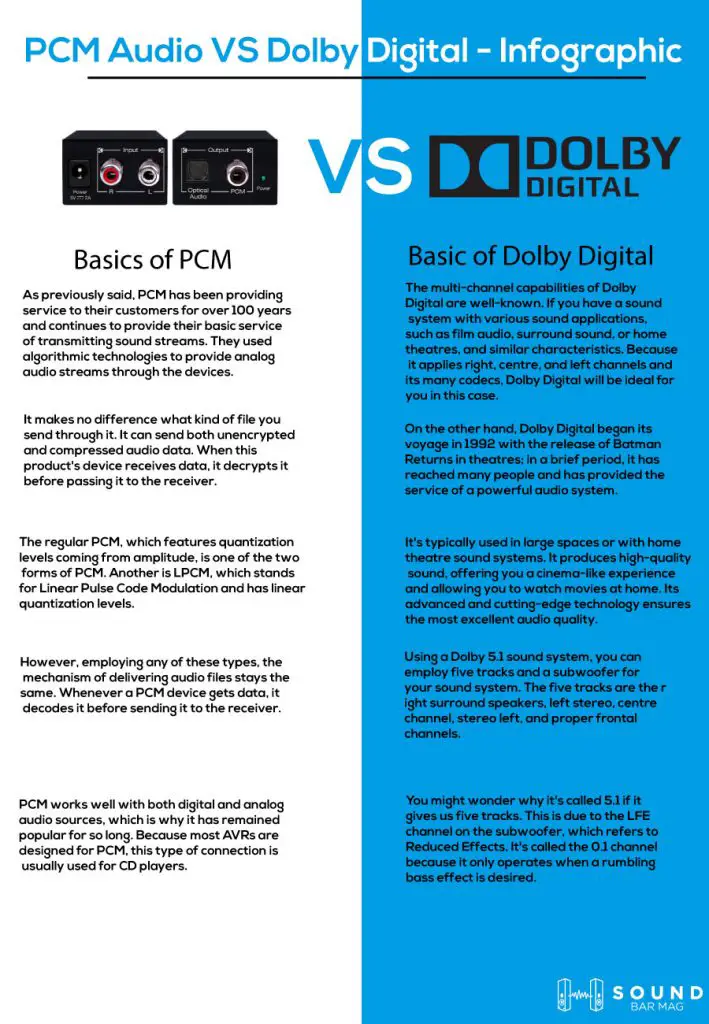Have you ever wondered how PCM and Dolby Digital audio differ? I’ll discuss the differences between these two fundamental sorts of sound in this guide.
When it comes to managing digital audio recordings, there are two central systems to choose from. The most common method for converting analog audio to digital audio is pulse-code modulation. It’s simply a two-channel stereo digital audio track when you see PCM music on a DVD.
Dolby Digital is a multi-channel signal commonly used in home theatres, movie theatres, and other similar applications. Its multiple variations use left, right, and centre channels. If your system is Dolby 5.1, you’ll have five tracks and a subwoofer to work with.
Since it has fewer speakers, most people consider PCM superior to Dolby Digital for technical requirements. This comparison’s reality is somewhat different.
To understand the difference between PCM audio and Dolby digital, you must know. Both PCM and Dolby digital audio can exist on any media.
PCM Audio VS Dolby Digital: What’s the Difference?
Dolby Digital is a cutting-edge technology that provides multi-channel audio and is found on nearly all DVDs and Blu-ray discs. On the other hand, PCM is the unstructured information streaming that the player can create out from Blu-ray for use in AVR receivers that may not be compatible with DTS or DD, even though 99.9% of modern technology systems support it.
PCM also supports little noises, such as Commentaries from the admins. These additional sounds may be added to the stream. A discussion suggests that different audio players and receptions may cause minor differences in the decoded audio stream, resulting in varied audio quality on other devices.
Aside from the highest data rate and individual frequency, there are constraints on the number of channels sent by the PCM stream.
Is PCM Preferable to Dolby Digital?
Dolby Digital is a multi-channel sound system format used in home theatres, film music, and similar applications. It includes left, right, and centre streams and a variety of forms. If your system is Dolby 5.1, it indicates you have five loudspeakers and a subwoofer.
Transforming an analog sound to a digital format is called pulse-code modulation (PCM). PCM is most commonly seen in DVDs, and it denotes the presence of a two-channel stereo electronic audio track. People argue that PCM is inferior to Dolby Digital regarding technical specifications since it has fewer channels. The truth, however, is somewhat different.
When choosing between PCM and Dolby Digital for sound quality, you must determine if you want unadulterated or reduced audio. The first option is stereo, while the second offers a variety of formats with additional compression.
The Basics of PCM
As previously said, PCM has been providing service to their customers for over 100 years and continues to provide their basic service of transmitting sound streams. They used algorithmic technologies to provide analog audio streams through the devices.
It makes no difference what kind of file you send through it. It can send both unencrypted and compressed audio data. When this product’s device receives data, it decrypts it before passing it to the receiver.
The regular PCM, which features quantization levels coming from amplitude, is one of the two forms of PCM. Another is LPCM, which stands for Linear Pulse Code Modulation and has linear quantization levels.
However, employing any of these types, the mechanism of delivering audio files stays the same. Whenever a PCM device gets data, it decodes it before sending it to the receiver.
PCM works well with both digital and analog audio sources, which is why it has remained popular for so long. Because most AVRs are designed for PCM, this type of connection is usually used for CD players.
The Basic of Dolby Digital
The multi-channel capabilities of Dolby Digital are well-known. If you have a sound system with various sound applications, such as film audio, surround sound, or home theatres, and similar characteristics. Because it applies right, centre, and left channels and its many codecs, Dolby Digital will be ideal for you in this case.
On the other hand, Dolby Digital began its voyage in 1992 with the release of Batman Returns in theatres; in a brief period, it has reached many people and has provided the service of a powerful audio system.
It’s typically used in large spaces or with home theatre sound systems. It produces high-quality sound, offering you a cinema-like experience and allowing you to watch movies at home. Its advanced and cutting-edge technology ensures the most excellent audio quality.
Using a Dolby 5.1 sound system, you can employ five tracks and a subwoofer for your sound system. The five tracks are the right surround speakers, left stereo, centre channel, stereo left, and proper frontal channels. You might wonder why it’s called 5.1 if it gives us five tracks. This is due to the LFE channel on the subwoofer, which refers to Reduced Effects. It’s called the 0.1 channel because it only operates when a rumbling bass effect is desired.
Related Posts:
- PCM VS Passthrough Soundbar [Detailed-Guide]
- Bitstream VS PCM – Which one is Better?
- PCM or Raw for Soundbar – [Detailed-Guide]
- Bitstream or PCM for Soundbar
- Is PCM Better than Dolby Digital? [Detailed-Guide]
- PCM vs Dolby Digital Sound Bar – Which One is Better?

Wrapping Up
Creating a comparison between Dolby Digital and PCM is equivalent to comparing grapefruits to apples. These two have pretty enough distinct advantages and features to make them distinct sound materials for a home theatre system.
Dolby Digital consistently outperforms the competition and has a more significant number of channels than PCM. If you can’t get those channels to work in your home, you can choose PCM as a substitute.
When choosing one or the other, it’s best to consider your system’s needs before picking the format with more channels or higher home theatre standards.

Mia Evelyn is a soundbar specialist and she love to test and review different soundbar brands. She shares her neutral and in-depth reviews through the Soundbar Mag.